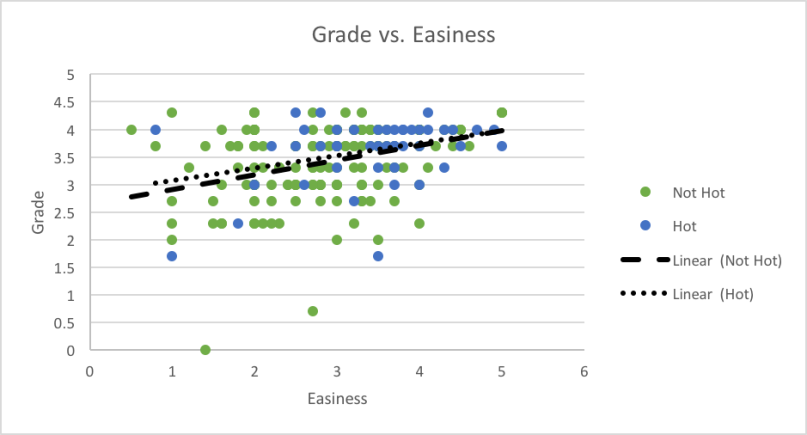As the final project of my Intro to Political Analysis class, we had to write a short paper proposing a solution to some puzzle, and then determining if our solution was correct. This is what I did:
Do Hot Teachers Teach Better?
Introduction.
Ratemyprofessors.com is a site where students can post ratings of professors they have had, evaluating them on “helpfulness,” “clarity,” and “easiness.” “Helpfulness” describes how available and approachable the professor is. “Clarity” describes how well the professor teaches the material. A teacher’s overall rating is the average of their clarity and helpfulness scores from everyone who has rated them. “Easiness” is not factored in, though students can still use this measure to rate “how easy or difficult a class is”. Students can also post the grade they received in the class, and they can note whether their teacher is “hot” or not. Hotness is not measured numerically, but teachers who are hot are marked by a red chili pepper on their page. If there are more students who say a teacher is hot than students who say a teacher is not hot, the chili pepper will appear, though the number itself is not displayed.
The puzzle here is that teachers who are “hot” seem to receive a higher overall rating—a 2006 paper from Medaille College found that teachers labeled “hot,” on average, scored 0.8 points higher on their overall rating, suggesting either that hot teachers are more helpful, and teach their material more clearly, or that students are biased toward giving hot professors better ratings, regardless of their quality as a teacher.
I believe the former, for a few reasons. First, younger professors are more likely to be perceived as “hot,” and are more likely to be able to communicate effectively with students because of a very small age gap. I also believe that students are more likely to perceive a helpful teacher as hot. So my prediction is that teachers who are hot are genuinely better teachers, and that students do not just perceive hot teachers as better. If this hypothesis is true, I would expect to see a correlation between the overall score of hot professors and the grade received in the class, and I would expect that correlation to be consistent with the correlation between the ratings and grades for not hot teachers—the assumption that I am making here is that a “helpful” and “clear” teacher will be better at teaching, so students will learn better, and receive higher grades.
While I will not be able to determine whether my specific reasons are the cause for hot teachers receiving higher ratings, I will at least be able to determine if the ratings reflect grades received.
Procedure.
I conducted my research by recording average grades, helpfulness, clarity, and easiness scores for 195 teachers at the University of Iowa, 44 hot and 151 not hot. I only looked at teachers with last names A-E, to provide a manageable, but hopefully diverse, pool of professors. I assigned grades a number value based on the GPA 4-point system, with Fs being 0s and A+s being 4.3s. Because reporting the grade received is optional, many teachers did not have any information for the average grade received in their classes. I did not include these teachers in my data.
Results.

The results appear to reject my hypothesis. While hot professors have a higher average grade than not hot professors (3.61 rather than 3.4 on a 4-point scale) there was no correlation between the overall rating the professor received and the average grades of the students. For not hot teachers, the higher the ratings of helpfulness and clarity, the higher the grade. For hot teachers, the trend line is flat. This suggests that students overrate the helpfulness and clarity of hot teachers, regardless of how well they do in their class.

Interestingly, for both hot and not hot teachers, there is a direct correlation between easiness and the grade received. This may result from the fact that “easiness” is a measure of the class rather than the professor—so students are more likely to be objective in measuring the difficulty of the class than they are in measuring how difficult it is to learn from a hot teacher.
Problems.
This paper I did is flawed. My sample size was small. There are many factors I could not control for. It may be that trend-lines are completely different depending on which class a teacher is teaching, or which year the students are in. It could be that no individual student overrates hot teachers, but that looking at the average of all students makes it appear that they do. It could be that there is some unknown factor that has a correlation with hotness and direct causation with grades and ratings, making it appear that hotness is the deciding factor. This is just an exploratory bit of analysis which appears to suggest one thing.
So, I encourage anyone who is interested, or curious about these things, to conduct your own studies. That’s how science works, after all.
Also, here are my data. And here are my sources:
Ratemyprofessors.com. 2016. “Help.” Help. http://www.ratemyprofessors.com/help.jsp (April 25, 2016).
Motahari, Nicole. 2014. “Is The Chili Pepper Just a Measure of How Attractive a Professor Is, or Is It More than That? – The Signal.” The Signal. http://georgiastatesignal.com/is-the-chili-pepper-just-a-measure-of-how-attractive-a-professor-is-or-is-it-more-than-that (April 25, 2016).


Interesting hypothesis. It could also be possible that hotness is distracting, or encourages superficial academic showing off more often than not.